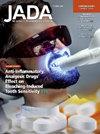Second molar sealants among US adolescents and their association with select sociodemographic factors and first molar sealants
IF 3.1
2区 医学
Q1 DENTISTRY, ORAL SURGERY & MEDICINE
引用次数: 0
Abstract
Background
Caries is an important public health concern. Dental sealants are effective in preventing caries; however, their uptake is suboptimal and little is known about second molar (2M) sealants. The authors examined the prevalence of 2M sealants among US adolescents and investigated the factors associated with their presence.
Methods
The authors conducted a cross-sectional analysis of 2011-2016 National Health and Nutrition Examination Survey data on adolescents aged 12 through 19 years with complete sealant data (n = 3,636). Race and ethnicity, income, and first molar (1M) sealant were primary variables of interest. The logistic regression models were used to estimate the factors associated with 2M sealants. All analyses used survey weights and accounted for complex survey design.
Results
Only 34.6% of adolescents (95% CI, 31.2% to 38.0%) had 2M sealants. Approximately 89.0% of adolescents (95% CI, 86.1% to 92.0%) with 2M sealants and 19.6% (95% CI, 17.1% to 22.2%) without 2M sealants had 1M sealants. In the adjusted models, race and ethnicity were strongly associated with 2M sealant presence, but the association did not hold when 1M sealant was included in the model. 1M sealants were the most significant factor explaining the presence of 2M sealants (odds ratio, 0.03; 95% CI, 0.02 to 0.04).
Conclusions
Two of 3 adolescents lacked 2M sealants, with considerable disparities in their presence. To improve adolescent oral health, clinical and community programs should increase delivery of 2M sealants.
Practical Implications
Study findings highlight the need to evaluate adolescent sealant delivery programs to improve the uptake of 2M sealants.
美国青少年第二颗臼齿封闭情况及其与部分社会人口因素和第一颗臼齿封闭情况的关系:一项利用全国健康与营养调查数据进行的横断面研究。
背景:龋病是一个重要的公共卫生问题。牙齿封闭剂能有效预防龋齿;然而,这种封闭剂的使用率并不理想,而且人们对第二磨牙(2M)封闭剂知之甚少。作者研究了美国青少年中 2M 密封剂的使用率,并调查了与使用 2M 密封剂相关的因素:作者对 2011-2016 年全国健康与营养调查数据进行了横断面分析,调查对象为 12 至 19 岁的青少年,他们拥有完整的密封剂数据(n = 3,636)。种族和民族、收入和第一磨牙(1M)密封剂是主要的关注变量。逻辑回归模型用于估计与 2M 密封剂相关的因素。所有分析都使用了调查权重,并考虑了复杂的调查设计:只有 34.6% 的青少年(95% CI,31.2% 至 38.0%)进行了 2M 密封剂治疗。约 89.0% 的青少年(95% CI,86.1% 至 92.0%)有 2M 密封剂,19.6%(95% CI,17.1% 至 22.2%)没有 2M 密封剂的青少年有 1M 密封剂。在调整后的模型中,种族和民族与 2M 密封剂的存在密切相关,但将 1M 密封剂纳入模型后,这种关联就不成立了。1M密封剂是解释是否存在2M密封剂的最重要因素(几率比,0.03;95% CI,0.02至0.04):3名青少年中就有2名缺乏2M密封剂,而且存在很大差异。为改善青少年口腔健康,临床和社区项目应增加2M密封剂的供应:研究结果强调,有必要对青少年密封剂提供计划进行评估,以提高2M密封剂的使用率。
本文章由计算机程序翻译,如有差异,请以英文原文为准。
求助全文
约1分钟内获得全文
求助全文
来源期刊

Journal of the American Dental Association
医学-牙科与口腔外科
CiteScore
5.30
自引率
10.30%
发文量
221
审稿时长
34 days
期刊介绍:
There is not a single source or solution to help dentists in their quest for lifelong learning, improving dental practice, and dental well-being. JADA+, along with The Journal of the American Dental Association, is striving to do just that, bringing together practical content covering dentistry topics and procedures to help dentists—both general dentists and specialists—provide better patient care and improve oral health and well-being. This is a work in progress; as we add more content, covering more topics of interest, it will continue to expand, becoming an ever-more essential source of oral health knowledge.
 求助内容:
求助内容: 应助结果提醒方式:
应助结果提醒方式:


